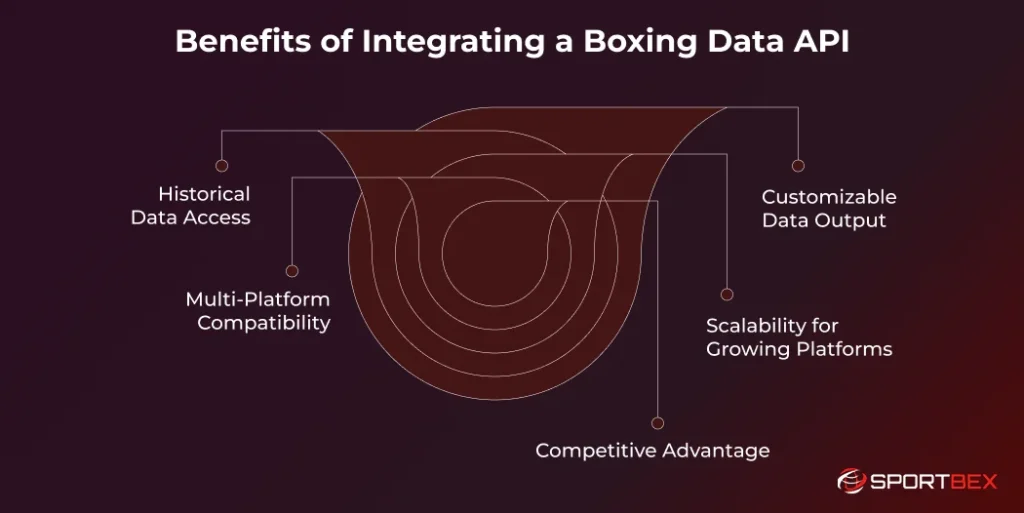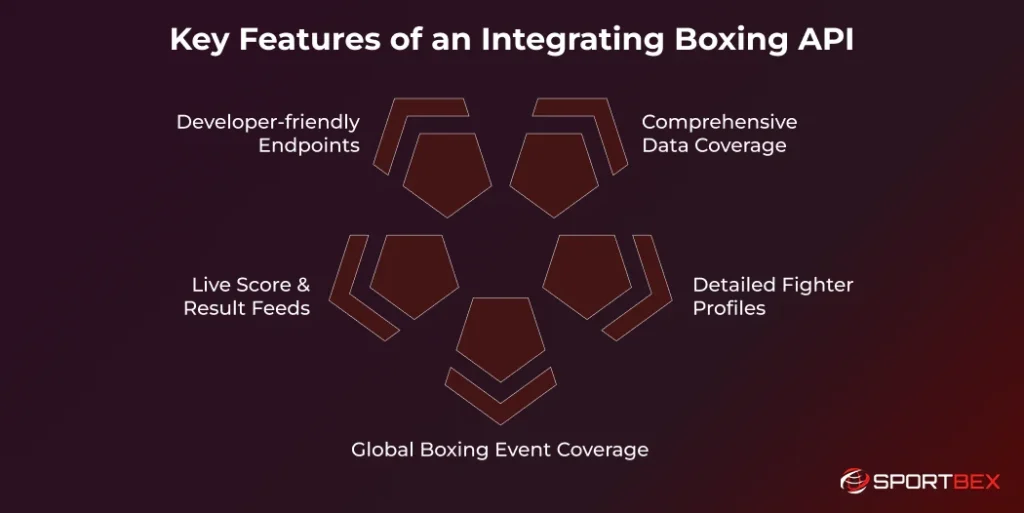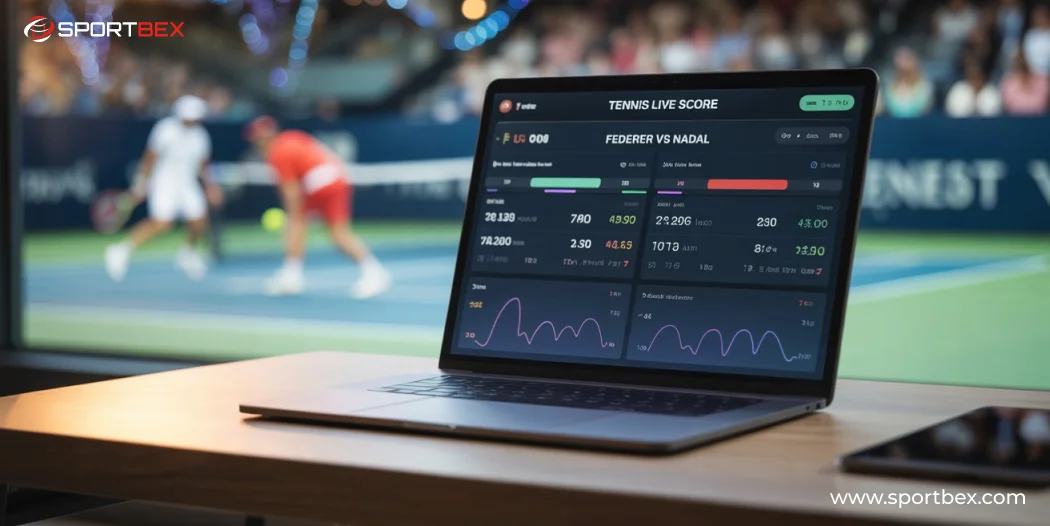Boxing has grown from basic scorecards and newspaper updates to advanced platforms that provide detailed stats, fighter insights, and live updates to fans around the world. Apps, websites, and media channels now depend on accurate, real-time boxing information to keep fans informed and engaged.
The challenge many developers and platform owners face isn’t just finding boxing data; it’s accessing reliable, structured, and comprehensive data through a boxing API that can seamlessly integrate with their existing systems. Manual data collection is time-consuming, error-prone, and simply doesn’t scale with the demands of modern sports platforms.
A Boxing Data API solves these challenges by providing automated access to extensive boxing datasets through simple API calls. Whether you’re building a sports betting platform, developing a fantasy boxing application, or creating a comprehensive boxing news website, integrating the right API can transform your platform’s capabilities and user experience. If you’re wondering how to integrate the Boxing Data API into your platform, the process is straightforward and can be customized to meet your project’s unique needs.
What Is a Boxing Data API?
A Boxing Data API is an online tool that lets you access detailed boxing information using simple web requests. It gathers data from sources like boxing organizations and event promoters and organizes it into easy-to-use formats like JSON or XML for developers.
Unlike traditional data sources that require manual updates or web scraping, a Boxing Stat Data API automatically delivers current information about fighters, matches, rankings, and statistics through simple API endpoints. By leveraging sports data feeds, your platform can access everything from historical fight records to live round-by-round scoring without maintaining a complex data collection infrastructure.
Most boxing data APIs operate on REST architecture, making them compatible with virtually any programming language or framework. They typically offer both pull-based endpoints for on-demand data retrieval and webhook systems for real-time updates, giving developers flexibility in how they implement and consume boxing information.
Benefits of Integrating a Boxing Data API

Historical Data Access
Using a boxing data feed powered by a sports data API gives you access to decades of boxing history. This means your platform can easily provide detailed fighter stats, head-to-head comparisons, and trend analysis—things that would be nearly impossible to gather on your own.
Historical data access allows users to research fighter performance patterns, analyze career trajectories, and make informed predictions based on past performance metrics. For sports betting platforms, this historical context is crucial for generating accurate odds and providing bettors with the information they need to make educated decisions.
Customizable Data Output
Modern Boxing player stats API services offer extensive customization options that allow you to request only the specific data points your platform requires. Instead of receiving overwhelming amounts of unnecessary information, you can tailor API responses to include precisely the fighter statistics, match details, or ranking information your application needs.
This customization capability extends beyond simple field selection to include data formatting options, update frequency preferences, and filtering parameters. You might choose to receive only championship bout information, focus on specific weight classes, or filter results by geographic regions, ensuring your platform delivers relevant content to your target audience.
Multi-Platform Compatibility
A well-designed boxing fighter profiles API integrates seamlessly across different platforms and technologies, from web applications to mobile apps and desktop software. This compatibility ensures consistent data access whether your users are browsing on smartphones, tablets, or desktop computers.
Cross-platform compatibility ensures seamless integration regardless of the technologies your development team uses. REST-based APIs offer universal access to boxing data for platforms like a Fantasy Sports app without the need for specialized libraries or complex integration procedures.
Scalability for Growing Platforms
As your platform grows and attracts more users, a robust Boxing API scales automatically to handle increased traffic and data requests without requiring significant infrastructure changes on your end. Professional API providers maintain redundant servers and content delivery networks that ensure consistent performance even during high-traffic events like major championship fights.
This scalability extends to data volume as well. Whether your platform serves hundreds or millions of users, API-based data access maintains consistent response times and reliability, allowing you to focus on platform development rather than data infrastructure management.
Competitive Advantage
Platforms that integrate comprehensive boxing data APIs can offer features and insights that set them apart from competitors relying on manual data collection or limited information sources. Real-time updates, detailed analytics, and comprehensive fighter profiles create engaging user experiences that build loyalty and drive platform growth.
The competitive advantage becomes particularly apparent during major boxing events when users expect immediate updates, accurate statistics, and detailed analysis. Platforms powered by reliable data APIs can deliver this information instantly, while competitors without proper data integration struggle to keep pace with user expectations.
Key Features of an Integrating Boxing API

Comprehensive Data Coverage
Boxing data APIs give you information on all major boxing organizations like WBA, WBC, IBF, and WBO, as well as regional groups. This means your platform can cover everything from local fighters to world champions, making it useful for all boxing fans.
Data coverage typically includes active fighters, retired legends, upcoming matches, historical results, and championship lineages. Many APIs also cover amateur boxing competitions, Olympic results, and emerging talent, providing a complete picture of the boxing landscape for platforms serving diverse audiences. For platforms that also offer Live Sports Streaming, integrating such comprehensive boxing data ensures viewers get real-time insights alongside the action.
Detailed Fighter Profiles
Modern boxing APIs deliver rich fighter profile information that goes far beyond basic statistics. These profiles include biographical information, physical measurements, fighting styles, trainer details, and career milestones that help users understand each fighter’s background and capabilities.
Advanced fighter profiles often include performance analytics, such as knockout percentages, average fight duration, opponent quality metrics, and career earnings information. This depth of detail enables platforms to create engaging fighter comparison tools and predictive analytics that enhance user engagement.
Global Boxing Event Coverage
Quality APIs give you access to boxing events from all over the world, including big Las Vegas fights and regional championships in growing boxing markets. This helps your platform reach global audiences and cover all levels of professional boxing.
Event coverage typically includes fight cards, venue information, broadcast details, ticket availability, and promotional content. Many APIs also provide historical event data, allowing platforms to offer retrospective analysis and anniversary content that keeps users engaged between major fight nights.
Live Score & Result Feeds
Capabilities enable platforms to deliver live round-by-round scoring, real-time sports data updates, and immediate results as fights conclude through a Real-time boxing API. This immediate access to current information keeps users engaged during live events and ensures your platform remains relevant throughout fight nights.
Live feeds often include judge scorecards, round summaries, significant strike statistics, and momentum shifts that provide users with detailed insights into fight progression. These features are essential for sports betting platforms and fantasy boxing applications where real-time information directly impacts user decision-making.
Developer-friendly Endpoints
Well-designed APIs provide clear documentation, intuitive endpoint structures, and comprehensive code examples that streamline the integration process. Developer-friendly features include consistent response formats, meaningful error messages, and detailed authentication procedures that reduce implementation time and complexity.
Many modern APIs also provide tools for developers in popular programming languages, support for webhooks to get real-time updates, and testing environments to try things out before launching. These features make it much easier to integrate APIs successfully.
Step-by-Step Guide to Integrate a Boxing Data API
Step 1: Select the Most Reliable Boxing Data API Provider
Choosing the right API provider is crucial for long-term platform success. Evaluate potential providers based on data accuracy, update frequency, coverage breadth, and technical reliability. Look for providers with established track records serving sports platforms and clear service level agreements regarding uptime and data quality.
Step 2: Register and Obtain API Credentials
Once you’ve selected a provider, complete the registration process and obtain your API credentials, typically consisting of an API key or token that authenticates your requests. Follow the provider’s authentication guidelines carefully, as proper credential management is essential for maintaining secure and reliable API access.
Step 3: Send Your First API Call
Start with simple API calls to familiarize yourself with the provider’s response format and endpoint structure. Most boxing APIs offer straightforward endpoints for retrieving fighter lists, upcoming events, or recent results that are ideal for initial testing and development.
Step 4: Process and Integrate Data into Your Platform
Design data processing workflows that can handle API responses efficiently while maintaining data integrity and consistency within your platform. Consider implementing data validation, transformation, and storage procedures that ensure API data integrates seamlessly with your existing database schema and application logic.
Step 5: Run Performance Testing & Optimization
Conduct comprehensive performance testing to ensure your API integration can handle expected user loads without degrading platform performance. Test different scenarios, including peak traffic periods, concurrent user sessions, and high-frequency data updates to identify potential bottlenecks or resource constraints.
Get a Ready-Made Platform On Rent.
Get Started Today
Conclusion
Successfully integrating a boxing data API extends beyond initial implementation to include ongoing optimization, monitoring, and feature enhancement. Regular performance reviews help identify opportunities to improve data processing efficiency, reduce API costs, and enhance user experience, especially for platforms in the iGaming Industry, through better data utilization.
Stay informed about API provider updates, new endpoint availability, and expanded data coverage that could benefit your platform. Many providers regularly add new features and data sources that can enhance your platform’s capabilities without requiring major integration changes.
Consider implementing data analytics that track how users interact with boxing information on your platform. These insights can guide decisions about which data points to prioritize, how to structure information displays, and what additional API features might improve user engagement and platform value.
Frequently Asked Questions
A Boxing Data API is a service that provides structured boxing-related information, such as fight schedules, live scores, and historical data, which can be accessed by developers through API endpoints and integrated into websites, apps, or fantasy platforms.
You can access fight schedules, live round-by-round updates, fighter profiles, historical results, rankings, event locations, and other in-depth boxing statistics.
Integration typically involves selecting a trusted API provider, obtaining authentication keys, making API calls to retrieve data, and displaying it in your platform’s interface, followed by testing and optimization.
Yes, many Boxing Data APIs offer real-time event updates, including live scores, round results, and fight progress, allowing users to stay updated instantly.
A Boxing Data API offers reliable, structured, and up-to-date data, saving development time, improving user engagement, and enhancing the overall user experience with accurate boxing stats.
Recent Blog
How to Access Real-Time Tennis Match Results Using an API
October 24, 2025
 8 min
8 min
How Data Analytics Is Transforming Cricket Strategy
October 23, 2025
 7 min
7 min






